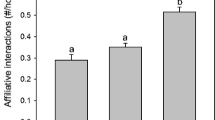Abstract
In a series of five experiments, female/female twin and male/male twin common marmosets were observed in each of the following social situations: as offspring in their respective family groups; housed together as twins; in competition for a mate and in the heterosexual pairs resulting from this competition. Quantitative records were made of their behaviour. These were then related to winning or losing the competition for a mate. Individuals who demonstrated more “assertive” behaviour and won the competition (winners) were not in every experiment faster to produce and rear offspring than were the less “assertive” animals (losers). Categories of behaviour described as “assertive” predicted the outcome of the competition in most cases, but were not good indicators of future breeding potential.
Similar content being viewed by others
References
Abbott, D. H. &J. A. Hearn, 1978. Physical, hormonal and behavioural aspects of sexual development in the marmoset monkey (Callithrix jacchus).J. Reprod. Fertil., 53: 155–166.
Epple, G., 1967. Vergleichende Untersuchungen über Sexualund Socialverhalten der Krallenaffen (Hapalidae).Folia Primatol., 1: 37–65.
————, 1968. Comparative studies on vocalization in marmoset monkeys (Hapalidae).Folia Primatol., 8: 1–40.
————, 1970. Maintenance, breeding and development of marmoset monkeys in captivity.Folia Primatol., 12: 56–76.
————, 1975. The behaviour of marmoset monkeys (Callitrichidae).Prim. Behav., 4: 195–239.
Fitzgerald, A., 1935. Rearing marmosets in captivity.J. Mammal., 16: 181–188.
Hearn, J. A. &S. F. Lunn, 1975. The reproductive biology of the marmoset monkey (Callithrix jacchus).Lab. Anim. Handb., 6: 191–202.
Ingram, J., 1975. Parent-infant interactions in the common marmoset (Callithrix jacchus) and the development of young. Ph.D. Thesis, Univ. of Bristol, Bristol.
Kleiman, D. G., 1977. Monogamy in mammals.Quart. Rev. Biol., 52: 39–65.
Pook, A. G., 1976. A comparative study of the vocalizations of the saddleback tamarin (Saguinus fuscicollis) and the common marmoset (Callithrix jacchus). Ph.D. Thesis, Univ. of Reading, Reading.
Rothe, H., 1971. Beobachtungen, Analysen und Experimente zum Handgebrauch vonCallithrix jacchus (Erzleben, 1777). Unpub. Ph.D. Thesis, Univ. of Keil, West Germany.
Stevenson M. F., 1977. The behaviour and ecology of the common marmoset (Callithrix jacchus jacchus) in its natural environment.Prim. Eye, 9: 5–6.
———— &T. B. Poole, 1976. An ethogram of the common marmoset (Callithrix jacchus): general behavioural repertoire.Anim. Behav., 24: 428–451.
White, C., 1952. The use of ranks in a test of significance for comparing two treatments.Biometrics, 8: 33–41.
Woodcock, A. J., 1982. The first weeks of cohabitation of newly-formed heterosexual pairs of common marmosets (Callithrix jacchus).Folia Primatol., 37: 228–254.
Author information
Authors and Affiliations
About this article
Cite this article
Woodcock, A. The social relationships of twin common marmosets (Callithrix jacchus) and their breeding success. Primates 24, 501–514 (1983). https://doi.org/10.1007/BF02381683
Received:
Accepted:
Issue Date:
DOI: https://doi.org/10.1007/BF02381683




